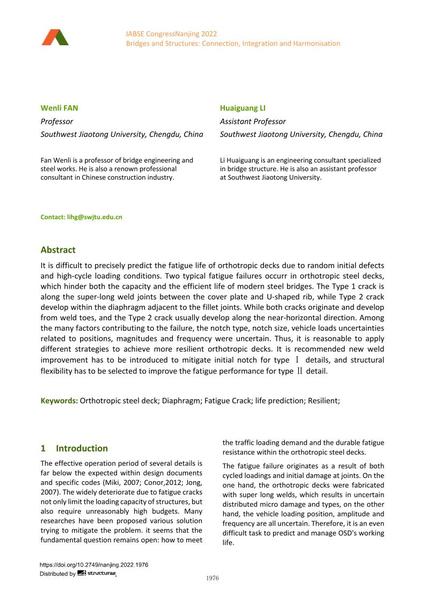Fatigue Resilient Design of Bridge Orthotropic Steel Deck

|
|
|||||||||||
Détails bibliographiques
| Auteur(s): |
Wenli Fan
(Professor; Southwest Jiaotong University, Chengdu, China)
Huaiguang Li (Assistant Professor; Southwest Jiaotong University, Chengdu, China) |
||||
|---|---|---|---|---|---|
| Médium: | papier de conférence | ||||
| Langue(s): | anglais | ||||
| Conférence: | IABSE Congress: Bridges and Structures: Connection, Integration and Harmonisation, Nanjing, People's Republic of China, 21-23 September 2022 | ||||
| Publié dans: | IABSE Congress Nanjing 2022 | ||||
|
|||||
| Page(s): | 1976-1981 | ||||
| Nombre total de pages (du PDF): | 6 | ||||
| DOI: | 10.2749/nanjing.2022.1976 | ||||
| Abstrait: |
It is difficult to precisely predict the fatigue life of orthotropic decks due to random initial defects and high-cycle loading conditions. Two typical fatigue failures occurr in orthotropic steel decks, which hinder both the capacity and the efficient life of modern steel bridges. The Type 1 crack is along the super-long weld joints between the cover plate and U-shaped rib, while Type 2 crack develop within the diaphragm adjacent to the fillet joints. While both cracks originate and develop from weld toes, and the Type 2 crack usually develop along the near-horizontal direction. Among the many factors contributing to the failure, the notch type, notch size, vehicle loads uncertainties related to positions, magnitudes and frequency were uncertain. Thus, it is reasonable to apply different strategies to achieve more resilient orthotropic decks. It is recommended new weld improvement has to be introduced to mitigate initial notch for type Ⅰ details, and structural flexibility has to be selected to improve the fatigue performance for type Ⅱ detail. |
||||
| Copyright: | © 2022 International Association for Bridge and Structural Engineering (IABSE) | ||||
| License: | Cette oeuvre ne peut être utilisée sans la permission de l'auteur ou détenteur des droits. |
||||
